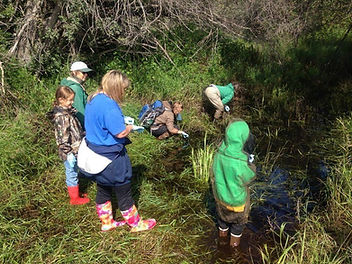
Alaska Herpetological
Society



Amphibians in Alaska's Classrooms
AHS has partnered with the National Park Service (NPS) to develop curriculum materials and kits for K12 schools throughout Alaska. These kits include educational materials (books, dvds, posters) and sampling supplies (nets, scales, thermometers, etc) for students to actively learn about Alaska's amphibians while engaging in meaningful research. The kits can be checked out to your school upon request by contacting Stacia Backensto (NPS) or Joshua Ream (AHS). The kits are limited, but we hope to increase their availability as this program grows and expands over time.
CLICK HERE FOR USEFUL CURRICULUM DOCUMENTS AND LINKS!
Teachers that would like to participate are encouraged to develop lesson plans that meet their specific needs. We know that mandated curriculum often dictates a teacher's ability to include additional content throughout the academic year, but we hope that you can integrate already developed themes with herpetological content. For instance, discussions on metamorphosis can include amphibian larval development. Or, discussions on food chains can include frogs as the prey of birds, fish, and mammals, but also the predator of many insect species! Our staff is willing and able to help you integrate herpetological themes in the classroom!
Beyond herpetological curriculum, we hope that some teachers will engage students in hands-on activities that allow students to participate in meaningful scientific research near their communities. Though handling amphibians and raising them in the classroom usually requires a permit (we can help you with this if you'd like to obtain one), studies that involve looking and listening can be undertaken anywhere at anytime! Here are some basic research examples for which the data would greatly benefit science:
1. Do amphibians occur at Pond X, Pond Y, and Pond Z? Studies that document the presence of amphibians in various wetlands are extremely useful. We know very little about the range of Alaska's native amphibians. A photograph of the individual, or even an audio recording of its call, is all that is needed to validate your find. Remember though, failure to find an amphibian doesn't necessarily mean they arnt there!
2. Do amphibians use Pond X as breeding habitat? Breeding habitat is perhaps the most important for the life histories of Alaska's amphibians. We can determine if a pond provides breeding habitat by listening for chorusing frogs in the spring, looking for egg masses and tadpoles in the water, and identifying breeding pairs!
3. When are amphibians breeding at Pond X? We call this breeding phenology. Though breeding is variable from year to year based on weather and ice conditions, long-term trends can be ascertained if records are kept over time. Recording the first date of amphibian chorusing at a pond in the spring can be a simple way of contributing to long-term datasets for a region!
4. What species of amphibian are present at Pond X? Throughout much of Alaska, the Wood Frog is the only amphibian species known to naturally occur, but you never know! In southeast Alaska and Prince William Sound, several other species may be present in a wetland system. Helping us to understand what species are present can be very valuable.
5. How many amphibians of a given species are occupying Pond X? Depending on the size of the pond, students can walk the edge of the wetland and count the number of amphibians seen. Over time, if this is repeated in a similar fashion from year to year, we can start to see trends in the population. Another way to record "abundance" is through spring call surveys.
The Wood Frog Monitoring Program of the Alaska Department of Fish and Game is an excellent way to get your classroom involved! CLICK HERE FOR MORE INFORMATION.
Pollywog in a Bog
Useful Documents and Links
The documents listed below may be useful in helping you to develop lesson plans for your students. We also provide links to curriculum materials developed by partner organizations!
DOCUMENTS
Sampling Forms (You can also submit individual observations by CLICKING HERE!)
Amphibians and Culture Curriculum Guide
Gosner Stages: Developed by Kenneth L. Gosner in 1960 and published in this article:
Gosner, Kenneth L. "A simplified table for staging anuran embryos and larvae with notes on identification." Herpetologica (1960): 183-190.
CURRICULUM LINKS
Frogs are Green (Art Curriculum)
Herp Curriculum Sampler (Developed for Pennsylvania Herps but lots of wonderful ideas!)
DID YOU KNOW?!
Featured Products
Newest Members
Donate!
Recent Blog Entries
